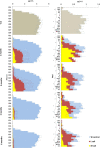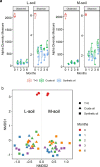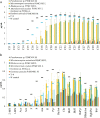Correlating the succession of microbial communities from Nigerian soils to petroleum biodegradation
- PMID: 37392206
- PMCID: PMC10314880
- DOI: 10.1007/s11274-023-03656-7
Correlating the succession of microbial communities from Nigerian soils to petroleum biodegradation
Abstract
Whilst biodegradation of different hydrocarbon components has been widely demonstrated to occur by specialist oil-degrading bacteria, less is known about the impact on microbial communities as a function of oil composition by comparing the biodegradation of chemically complex fuels to synthetic products. The objectives of this study were (i) to assess the biodegradation capacity and succession of microbial communities isolated from Nigerian soils in media with crude oil or synthetic oil as sole sources of carbon and energy, and (ii) to assess the temporal variability of the microbial community size. Community profiling was done using 16 S rRNA gene amplicon sequencing (Illumina), and oil profiling using gas chromatography. The biodegradation of natural and synthetic oil differed probably due to the content of sulfur that may interfere with the biodegradation of hydrocarbons. Both alkanes and PAHs in the natural oil were biodegraded faster than in the synthetic oil. Variable community responses were observed during the degradation of alkanes and more simple aromatic compounds, but at later phases of growth they became more homogeneous. The degradation capacity and the size of the community from the more-contaminated soil were higher than those from the less-contaminated soil. Six abundant organisms isolated from the cultures were found to biodegrade oil molecules in pure cultures. Ultimately, this knowledge may contribute to a better understanding of how to improve the biodegradation of crude oil by optimizing culturing conditions through inoculation or bioaugmentation of specific bacteria during ex-situ biodegradation such as biodigesters or landfarming.
Keywords: Degradation capacity; Oil biodegradation; PAHs; Pre-exposure; Soil microbial communities.
© 2023. The Author(s).
Conflict of interest statement
The authors have no relevant financial or non-financial interests to disclose.
Figures






Similar articles
-
The Interactive Effects of Crude Oil and Corexit 9500 on Their Biodegradation in Arctic Seawater.Appl Environ Microbiol. 2020 Oct 15;86(21):e01194-20. doi: 10.1128/AEM.01194-20. Print 2020 Oct 15. Appl Environ Microbiol. 2020. PMID: 32826215 Free PMC article.
-
Oil spill surface washing agents and chemical herders drive microbial community structure impacting biodegradation.Appl Environ Microbiol. 2025 May 21;91(5):e0233424. doi: 10.1128/aem.02334-24. Epub 2025 Apr 22. Appl Environ Microbiol. 2025. PMID: 40261044 Free PMC article.
-
Microbiome and imputed metagenome study of crude and refined petroleum-oil-contaminated soils: Potential for hydrocarbon degradation and plant-growth promotion.J Biosci. 2019 Oct;44(5):114. J Biosci. 2019. PMID: 31719223
-
The role of microorganisms in petroleum degradation: Current development and prospects.Sci Total Environ. 2023 Mar 20;865:161112. doi: 10.1016/j.scitotenv.2022.161112. Epub 2022 Dec 28. Sci Total Environ. 2023. PMID: 36586680 Review.
-
Microbial communities in petroleum-contaminated sites: Structure and metabolisms.Chemosphere. 2022 Jan;286(Pt 2):131752. doi: 10.1016/j.chemosphere.2021.131752. Epub 2021 Aug 2. Chemosphere. 2022. PMID: 34426136 Review.
References
-
- Banerjee DK, Fedorak PM, Hashimoto A, et al. Monitoring the biological treatment of anthracene-contaminated soil in a rotating-drum bioreactor. Appl Microbiol Biotechnol. 1995;43:521–528. doi: 10.1007/BF00218460. - DOI
MeSH terms
Substances
Grants and funding
LinkOut - more resources
Full Text Sources
Molecular Biology Databases

